How To Choose A Blog Niche That Makes Money And Dominate It
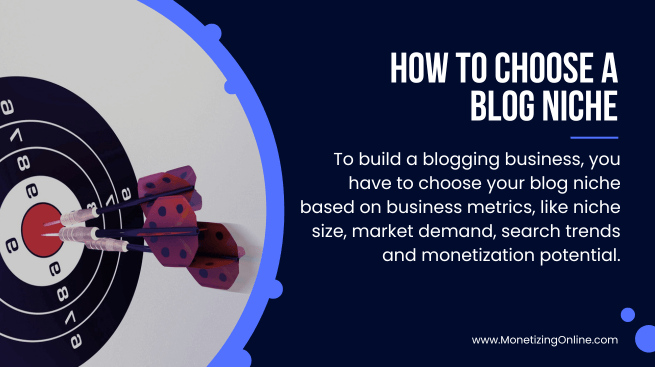
Understanding how to choose a blog niche that makes money before you start blogging is crucial for the earning potential of your blog and its long-term success.
But with so many potential niches out there, how do you know which one is the best fit for you when starting a blog?
In this how to choose a blog niche that makes money article I will cover:
1. Important things to consider before selecting a niche.
2. How to choosing a profitable blog niche using leading business and blogging indicators, instead of personal passions.
3. How the right niche will turn your blog into a real online business and not just a hobby.
Let’s dive into it as we have a lot of ground to cover.
How to Choose a Blog Niche that Makes Money?
To understand how to choose a blog niche that makes money, first it’s essential to determine what a blog niche is.
What is a Blog Niche?
A blog niche is a specific topic or theme that your blog focuses on. Choosing a niche will help you attract a specific audience and create content that resonates with them, and establish your authority in the field. A niche can be broad, such as travel or health, or more specific, such as vegan meal prep or minimalist fashion.
Things to Consider Before Selecting a Niche
1. Focus on One Niche Only
There are hundreds of niche ideas that you can choose from including fitness, fashion, travel, meditation, technology, cooking, and the list goes on. However, it’s important to focus on a single niche or you run the risk of spreading too thin.
Single niche blogs also build more authority in their space. So, Google is more favourable towards them, increasing their chances of ranking higher and generating more organic traffic.
Think about it, if we have 2 blogs:
1. Dedicated solely to rock climbing.
2. Publishing blog posts about photography, rock climbing, and travel.
The first blog is more likely to rank higher for the term best rock climbing shoes because it’s laser-focused on rock climbing. That signals to the search engines that the blog offers higher-quality, more valuable content. As a result, it provides a better user experience than the second blog.
2. Select a Broad Niche
Another element to consider when choosing your niche is how broad it should be.
What do I mean by that?
If you want to rank in a broad niche like technology, instead of creating content about everything and anything in that niche, establish your authority in one large segment. For example, mobile technologies – mobile phones, laptops, tablets, smart watches, the networks that connect them, the software and the applications they use. There are plenty of topics to cover.
This will make it easier to:
1. Determine who your audience is and target it correctly.
2. Identify the pain point of your readers.
3. Keep your blog content structured and connected.
4. Create authority as an expert in the field.
5. Generate revenue from your blog faster.
I wouldn’t recommend narrowing down your niche any further as you could end up with a very small audience and limited demand.
Now that we have established these initial criteria, let’s look at the key factors you need to focus on when considering how to choose a blog niche that makes you money.
Most bloggers will advise you to choose a blog niche based on your passion, arguing that it’ll help you stay motivated and avoid writer’s block. The common belief is that your ideal niche is where your passion, interests, skills, and knowledge meet.

There are 3 problems with this approach:
1. It doesn’t include monetization.
2. It only focuses on you, completely ignoring your audience.
3. It doesn’t consider that blogging is a Google-driven business.
This strategy could work for a personal blog. But, if your goal is to make money blogging, this is a recipe for failure.
Investing time and effort without gaining any financial return or readership for a long period will discourage you, your passion will fade away and eventually, you’ll give up.
When I started this blog, it wasn’t my passion that kept me focused and helped me maintain my writing schedule. It was the reason why I started the blog.
What is your WHY?
Establish why you want to start a blog:
- Do you want to make money blogging?
- Do you want to replace your job’s income?
- Are you sick and tired of your 9-5 and want to escape it?
- Do you want more free time to spend with your loved ones?
- Do you want to work remotely from anywhere in the world?
Here are some of the most popular responses from new and pro bloggers:
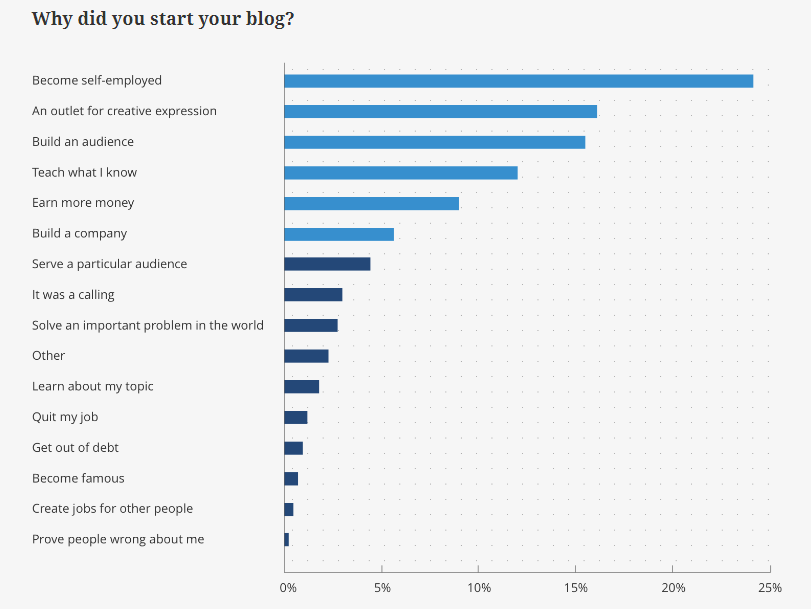
– Image Source: convertkit
The stronger and well-defined your reason, the easier you’ll find a way to reach your end goal.
This blog was a way for me to achieve financial freedom, so I can quit my office job and have more time to spend with my family.
I understood early on that blogging can’t be sustained on passion alone. That’s why I used my reasons and vision and turned them into purpose, which kept me on track and motivated.
Let’s assume that you take the general blogging advice:
1. You choose a niche you’re passionate about.
2. Create a blog with WordPress.
3. Write and publish 50 posts a year.
4. Start monetizing your site with Google AdSense.
5. Once you build an audience, add affiliate links to your articles.
This all sounds good however, do you remember in the beginning we said we’ll start your blog as a real online business?
The main purpose of a business is to provide value while making a profit in the process.
Before you choose your blog niche based on passion, ask yourself the following questions: can you scale and monetize your passion? What is the size of the chosen niche? Is the audience large enough? Are there problems that you can solve in the niche? Is the audience willing to pay you to solve their problem?
This formula will most likely take 3-5 years for your blog to gain traction and start making money because from the beginning your focus is on passion.
Think about it logically, no successful business was ever built purely on passion.
Let’s say you’re passionate about cars and you want to start an e-commerce business selling products in the car accessories niche.
Will you buy stock, create a website, upload product images, and promote the business using online channels, hoping that customers will find the store and buy your products? Leaving your success to chance.
Or instead, will you try to increase your chances for success by first doing some research about:
- The size of your niche and potential target clients.
- The wholesale price of the products.
- The resell price you can charge (your sales margin).
- How much are similar items selling for?
- Are the customers willing to pay the price for the product?
- Can you make a profit after all your expenses?
If it turns out your online store won’t be profitable, you’ll probably consider a different niche.
You’d rather pursue a profitable niche you’re not passionate about than a non-profitable one.
Only if the findings are showing your business idea is expected to be profitable, you’ll then invest in a website, stock, marketing, and promotion.
Now, let’s approach your blog the same way, like a real online business, using the reverse engineering method. If your goal is to make money blogging, working backward will help you understand the steps that you need to take to reach your goal in the fastest possible way.
To do this, we won’t choose your niche based on passion; instead, we’ll use a combination of key blogging metrics that will determine the long-term success of your blog:
- Market Research
- Blog Earning Potential
- Affiliate Revenue Generation
- Keyword Research
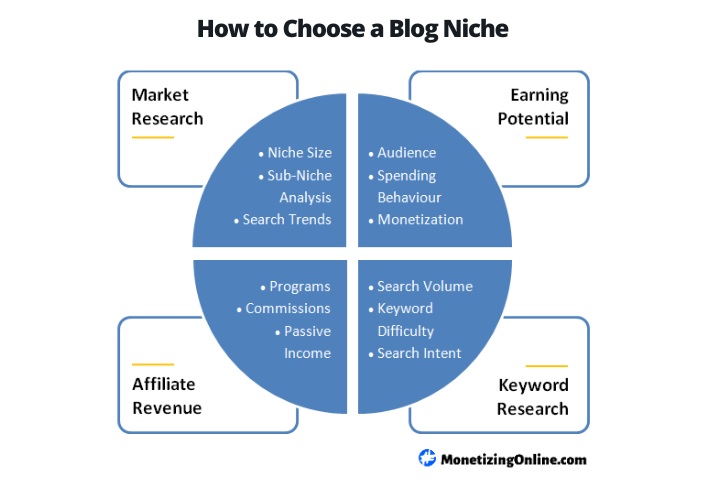
1. Market Research
Choosing the right niche is a pivotal element in the process of learning how to start a blog, but it’s almost always neglected. Many new bloggers rush through this part, so they can start writing.
However, keep in mind that you’re a business owner, not just a copywriter or content creator.
And as such, when selecting a niche the first thing to consider is how to choose a blog niche based on market research. You need data to get a general idea of the total addressable market, niche size, and competitive landscape, before you get to the writing.
Full-time bloggers will recommend finding a small niche for your blog to avoid competition and easily monetize it.
There are a few problems with this approach:
1. Small niches have small audiences and not enough demand, scalability, and earning potential.
2. A tiny niche won’t generate enough data to use as feedback to improve and adapt your content or pivot.
3. The lack of competition suggests that monetization prospects are low.
Don’t pigeonhole yourself in a small niche, thinking your posts will rank higher if you avoid competition. Instead, select a broader niche where you can identify different sub-niches and publish content to test them until you find the ones that work. This will allow you to pivot as and when necessary.
You also want to look for emerging terms and trending topics in the sub-niches, making it easier to rank for these terms before the competition has entered.
You can’t force Google to rank your content, but you can use its data to understand what sub-niches you rank for on the top pages. Let the search engines tell you what areas they consider you an expert in and pursue them by aggressively publishing content so you can dominate these sub-areas.
One of the key elements of how to choose a blog niche that makes you money lies in the ability to generate revenue from multiple sub-niches in the main niche.
To put this into perspective:
Let’s say you start a blog about personal finance, focusing on credit cards. There’s only so much you can write about and you’re restricted to affiliate revenue from one product.
Instead, you want to cover all aspects of personal finance: credit cards, savings mortgages, loans, checking accounts, insurance, investments, and so on. To get ahead of the curve, publish content on the emerging trends in the niche like the use of AI in personal finance, positioning your blog to outrank any new entrants in the field.
Creating content about multiple products and services in multiple categories will help you increase your blog’s income 10 fold.
It’s a numbers game.
If you have 10 people buying from your affiliate links per month in a sub-niche, to maximize your revenue you’d rather have:
10 people x 10 different categories = 100 sales per month.
Compared to:
10 people x 1 category = 10 sales per month.
Performing a quick 15-20 minutes of market research and using the correct tools will play a huge role in how to choose a blog niche that makes you money.
Here is how to do it.
Let’s say that you want to launch a blog in the Personal Development niche. Before you start publishing content, you want to determine the size of the niche as well as what sub-niches and pockets you can cover.
Start by searching for your topic on Google.
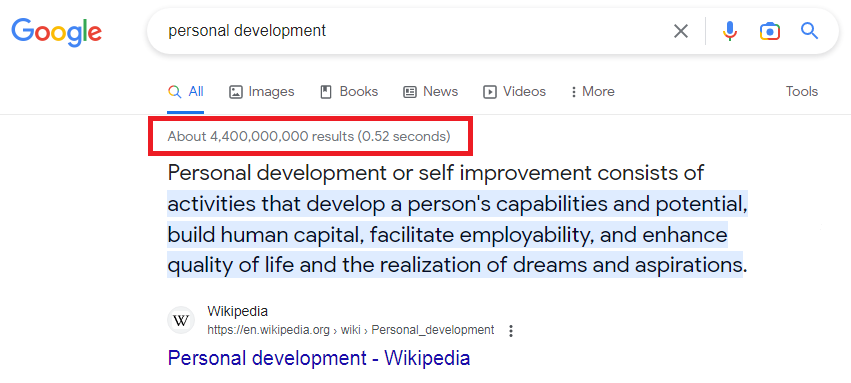
The search returns a large amount of results, suggesting that the Personal Development niche is broad enough with enough sub-niches to approach.
To generate sub-niche ideas, scroll to the bottom of the search results page where you can find related search variations.
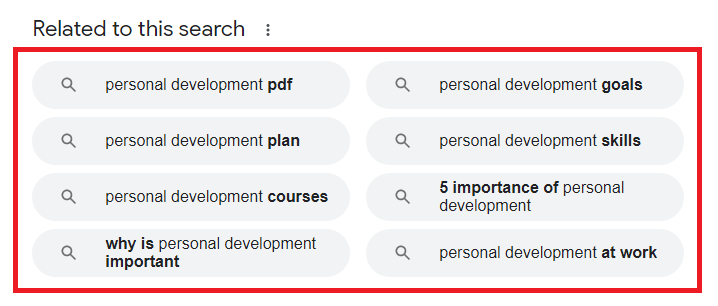
Now let’s check how many people search for this Personal Development topic every month.
To obtain the data, go to Google Ads Keyword Planner and enter the term.
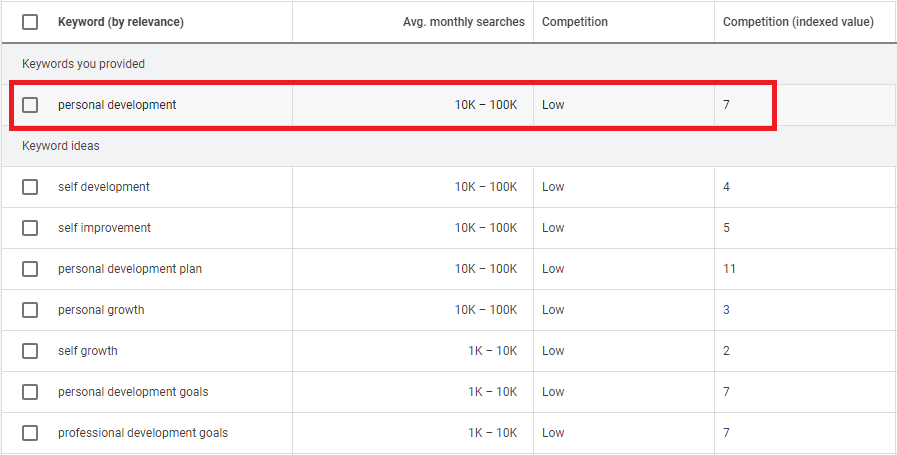
Personal development could be a good choice for a niche. It has a high number of monthly searches and low competition. But more importantly, it’s broad enough with several sub-categories to pursue, including time management and productivity, mindfulness and meditation, goal setting and achievement, self-confidence, communication skills, public speaking, emotional intelligence, self-awareness, and more.
However, try to get precise monthly search data when you’re researching how to choose a blog niche. To do so, you can use tools like Semrush. It’ll help you find your ideal niche faster. It’s the best tool to generate a ton of other high-volume, low-competition keywords to target in your blog posts as well.
To build a sustainable blog, it’s also important to understand if the overall trend of your niche is rising, declining, or flat over time.
Head over to Google Trends and type in personal development.
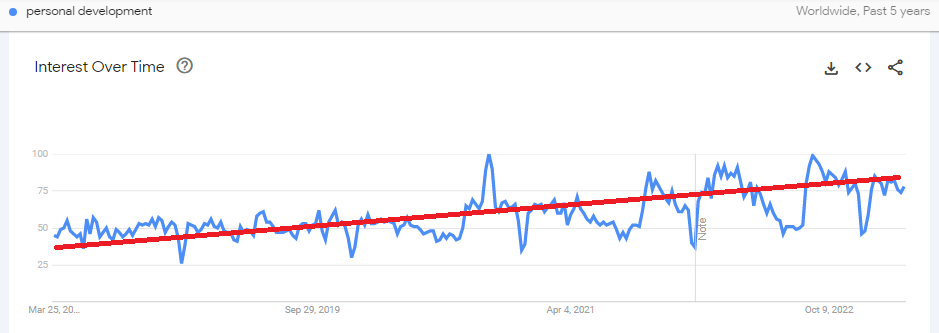
The search trend is steadily increasing, signalling that the audience in this niche is also growing over time.
Stay away from topics on a declining search trend.
If your chosen niche is attracting more interest over time, it’ll help you grow your blog and scale it in line with the increasing search volume and expanding audience size.
In fact, Grand View Research reports that the global personal development market size in 2021 was $41.81 billion, forecasting it’ll grow to $67.02 billion in 2030, indicating that the uptrend will continue during the next decade.
After completing the niche research it’s time to look at the revenue potential of your blog. I cover how to evaluate it and the role it plays in how to choose a blog niche that makes money.
2. Blog Earning Potential
Three main factors that can help you estimate the income potential of your blog even before you’ve started it:
1. Understand your target audience.
2. Determine the spending behaviour in your niche.
3. Effective use of monetization methods at different stages of your blog.
Your goal as a blogger is to truly understand your audience and address their pain point by providing solution-based content. Once the audience enters your sales funnel, you can move them down the funnel, leading them to make a purchase.
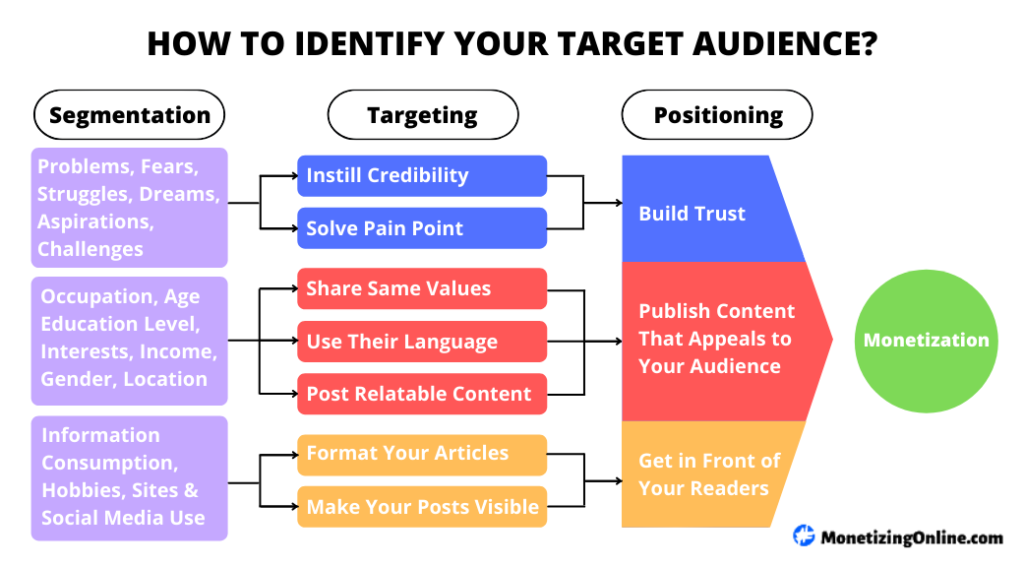
To gain a deeper understanding of your audience put yourself in their position. It’ll make it easier to understand their way of thinking, the challenges they face, and the rationale behind their buying decisions.
Let’s look at Apple as an example.
Who and why buys Apple products?
- The largest segment of buyers is 25-44 years old.
- Media and tech-savvy people.
- Creative professionals, students, managers, and young professionals.
- Middle to high-income and affluent consumers.
- They value quality, performance, design, innovation, and advanced hardware and software capabilities.
- These consumers are willing to pay a premium for Apple products because they believe they offer a better user experience and superior value compared to other brands in the market.
It’s clear that you not only need to solve a problem for your audience, but you need to solve a problem your audience is prepared to pay for.
Some of the most lucrative niches, where the audience is willing to spend the most, include food, travel, personal finance, marketing, lifestyle, mommy blogs, home decor and improvements.
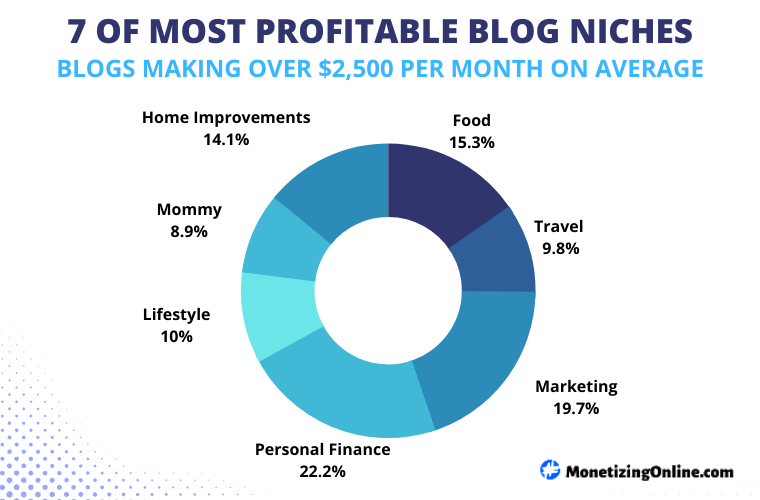
-Data source: rankiq
To determine the income potential of your selected niche, research how much the audience is spending and how much the competitors are making.
Understanding your audience, their spending habits and using the correct monetization strategy will transform your website into a real online business and not just a personal blog.
Most bloggers will suggest using multiple revenue streams when it comes to monetization, with Google Ads, affiliating programs, and the sale of digital products like online courses. These are the most popular choices as they’re the most passive.
This approach, however, is counterproductive since these revenue streams need a larger number of visitors to generate income. As a new blog, you’ll start with a small audience and limited traffic; thus you want to make the most of it by using a monetization strategy in line with your monthly visitors.
The most efficient way to monetize a new blog is through consultancy or 1 on 1 coaching. It’s less passive, but the low volume, high price consulting model allows you to start generating revenue faster without much traffic.
Let me explain with some simple example calculations.
If your new blog has 100 unique visits per month and your conversion rate is 2% on average, it means that you can make 2 sales per every 100 visitors.
Normally, you can generate $0.02-$0.10 per page view from Google AdSense.
- 100 visits x $0.10 = $10 per month
As an affiliate, you can earn $50 per sale (depending on niche and product).
- 100 visits x 2% conversion = 2 sales per month
- 2 sales x $50 = $100 per month
But if you’re offering online consulting, you can charge $1000 a client per month.
- 2 sales x $1,000 = $2,000 per month
To supercharge your blog’s revenue, choose a lucrative niche, and instead of chasing income from low-revenue ads and affiliate links at the beginning, when your traffic is low focus on selling high-ticket consulting services.
This strategy can get you from $0.00 to $10,000 monthly income in 6 months.
There’re different revenue streams you can use to monetize your blog, but because profitability hides in the numbers, you only need to offer consulting in the beginning.
When your audience starts to grow over time you can swiftly transition from consulting to passive income from affiliate marketing and advertising, leading us to the next step in how to choose a blog niche that makes you money.
3. Passive Income from Affiliate Marketing
Affiliate marketing is the best way to generate passive income once your blog starts driving traffic. It allows you to make money 24/7 without much input, so you no longer need to trade time for money.
Affiliate marketing is an advertising model based on recommending products and services of other companies. In exchange, the affiliate earns a commission on each sale through a unique link associated with the recommendation.
Here is how making money with affiliate programs works:
- You sign up for an affiliate program on the company’s site or through an affiliate network.
- After the approval of your application, you get your unique affiliate tracking link and access to performance data and reports to help you track: clicks, sales, and any future payments due to be paid to you.
- Insert the link in your blog content, creating a [hyperlink].
- When a user clicks on your unique link, it redirects them to the company website. At the same time, a tiny file (cookie) tracking activity for 30 to 90 days is stored on their browser. Even if a transaction isn’t made on the spot, any purchases during the tracking period are still credited to you.
- A customer purchases from the website.
- The system records the sale through your tracking link.
You get paid a commission on the sale.
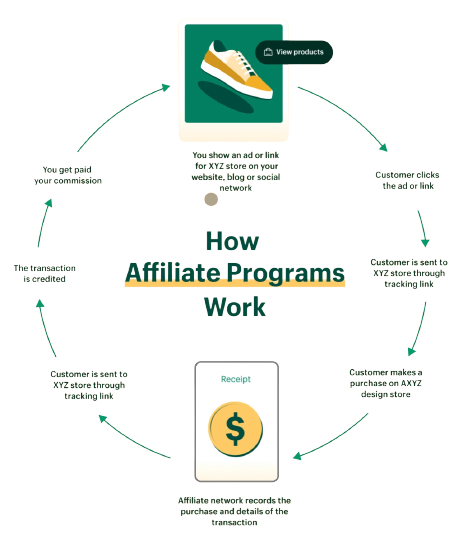
-Source: shopify
Affiliate programs are free to join, and since there’s no upfront cost you can start generating revenue right away. You can earn between 5%-50% or get a flat rate per sale. You can also earn recurring revenue or receive a one-off payment per sale. Commission rates and payout structures depend on the product or service you recommend and the affiliate program terms.
To generate passive income with an affiliate blog, you need to be in a lucrative niche with strong affiliate revenue potential.
Therefore, when choosing a niche, an important thing to consider is how to choose a blog niche based on the potential to generate affiliate revenue.
The most profitable niches for new blogs are personal finance, marketing, travel, technology, crypto, making money online, fitness and well-being.
Familiarise yourself with the most successful blogs in the niche you’re planning to pursue, so you can understand how they earn affiliate income and emulate their tactics and strategies.
A good source for inspiration and ideas are blogs like:
- Crypto/Stocks – CryptoVantage, HedgeWithCrypto, Benzinga
- Technology – Gizmodo, TheVerge, CNET, TechRadar
- Finance – MillennialMoney, GoodFinancialCents, TheCollegeInvestor
- Software – G2.com, PCmag, SoftwareReviews.com
- Fitness & Well-being – Health.com, Prevention, MensHealth, Self.com
What these blogs have in common is that all of them publish long-form, high-quality reviews and how-to articles on multiple sub-topics of their main niche.
The blog posts generating the highest revenue in most niches are list or review posts, including the word “best” in their title. These are transactional posts with high search volume and high conversion.
People searching for best + product or service are often ready to buy; they’re just looking for the right solution.
If you Google “best electric bikes”, the results on the first page are only affiliate blogs. Google ranks them higher than the e-bike shops during searches because they publish long-form, in-depth content, and reviews.
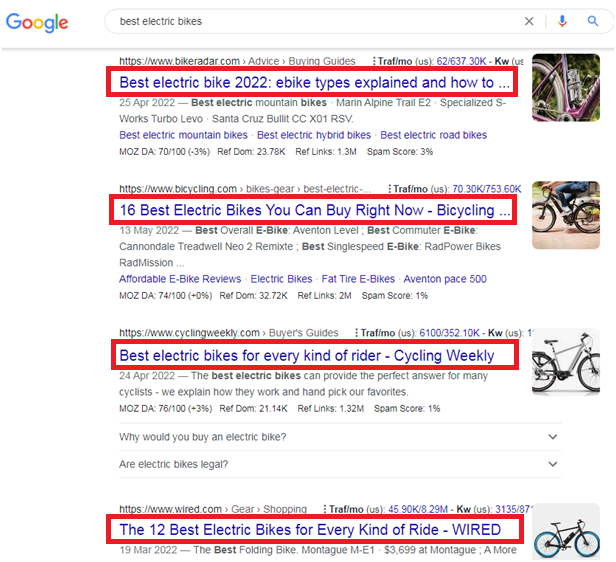
You can search for “best crypto cold wallets” or “best cameras for underwater photography” and you’ll get the same results.
The more you understand the concept of affiliate marketing, the more you will start noticing affiliate sites all over the internet.
To make money with an affiliate blog you need to pick up a profitable niche with high commission paying affiliate programs and publish quality review posts that rank on the first pages of Google based on specific keywords.
Now let’s look at how to choose a blog niche that makes you money and the role of keyword research when it comes to planning and choosing your blog niche.
4. Keyword Research
Keyword research is the fourth and perhaps the most important element in the process of how to choose a blog niche that makes you money.
Ask yourself: How many people are searching for the topics I’m planning to write about?
Each blog post you publish needs to focus on one keyword only. But, if no one is searching for the keyword you’re targeting, no one will find your content, and your blog won’t get traffic.
So, when you start a blog it’s useful to have a basic understanding of how to do effective keyword research, including search volume, keyword difficulty, and search intent.
User search intent is the specific reason why someone is searching online.
There are four main types of search intent:
1. Transactional – users are looking to make an immediate purchase.
2. Informational – people searching for information on a specific topic.
3. Navigational – when you want to visit a particular website [Amazon].
4. Commercial – users who research a potential future purchase.
Transactional posts typically contain an intent-specific word like “Best” or “Buy” + keyword, for example, Best Video Conferencing Software.
Whereas informational articles include words like “How-to”, “Best-way-to” or “Why”, a good example is How to Make Money Online.
You want to publish 65% transactional and 35% informational posts. You only need to focus on these 2 types of search intent as they’ll drive the most traffic and revenue for your blog.
To find valuable keywords to target, you have to determine their monthly search volume and keyword difficulty.
Luckily, there’re various SEO tools available to help you understand and use the search data to your advantage. You can use SEMrush, SE Ranking, and Moz Pro to filter through keyword metrics like:
1. Monthly Search Volume
The average number of monthly searches for a given keyword. Monthly search volumes can be grouped into Low, Medium, High and Very High.

2. Keyword Difficulty (KD)
It estimates how easy it is to rank for a keyword on the first page of Google during organic searches. Keyword difficulty measures the competition on a scale from 1 to 100. The scale is divided into 4 levels: Easy, Medium, Hard and Very Hard.

3. Cost-Per-Click (CPC)
This is the amount of money spent for each click in a paid marketing campaign. Even though we don’t want to run paid ads, it’s important to know that the higher the CPC, the more valuable the word.
4. Keyword Ideas
It helps you find variations of your target keyword and check which ones have the highest search volume and the lowest competition.
Now that you understand search volume and keyword difficulty, let’s combine these individual metrics to help you find valuable keywords to target.
From a search engine optimization (SEO) perspective, we can generate various combinations with these 2 components.

Many new bloggers use the traditional keyword research approach and go after low volume-low competition terms. However, these keywords have very low and inconsistent search volume and won’t drive any revenue. Instead, when you’re identifying how to choose a blog niche that makes you money, it’s vital to understand that your new blog needs a mixture of medium volume-low competition and very high volume-high competition keywords.
1. Medium Volume-Low Competition Keywords
You want to find and target medium volume-low competition keywords in your content as these are the revenue drivers for your blog.
For example, if you’re creating an outdoor sports blog, you can write an article on “Best Snowboard Brands”. Using the SEMrush keyword research tool we can see that the term has the following metrics:
- Keyword: Best snowboard brands
- Monthly search volume: 6,600
- Keyword difficulty: 17
- Cost-per-click: $11.79
Keyword difficulty is low at 17, suggesting that ranking for this term should be relatively easy.
And because we know that a page ranking number 1 on Google gets 32.5% traffic on average, we can calculate that position 1 will bring in 2,145 monthly organic visitors. On top of that, your post can rank for hundreds of variations of the main keyword, such as winter sports equipment, snowboarding gear, and equipment for snowboarding, pulling additional 2,000-4,000 monthly page visits.
The CPC is also high, meaning that the keyword has commercial value.
The keyword contains the word “best”, indicating strong search intent which you can match with list-type, transactional posts.
When looking for relevant keywords to target, it’s important to search for more specific terms. Instead of workout search for high-intensity interval training or Crossfit exercises; instead of shoes, try searching for running shoes.
Make sure to check the keyword suggestions for other variations of the term that you can either target or include in your content and headings.
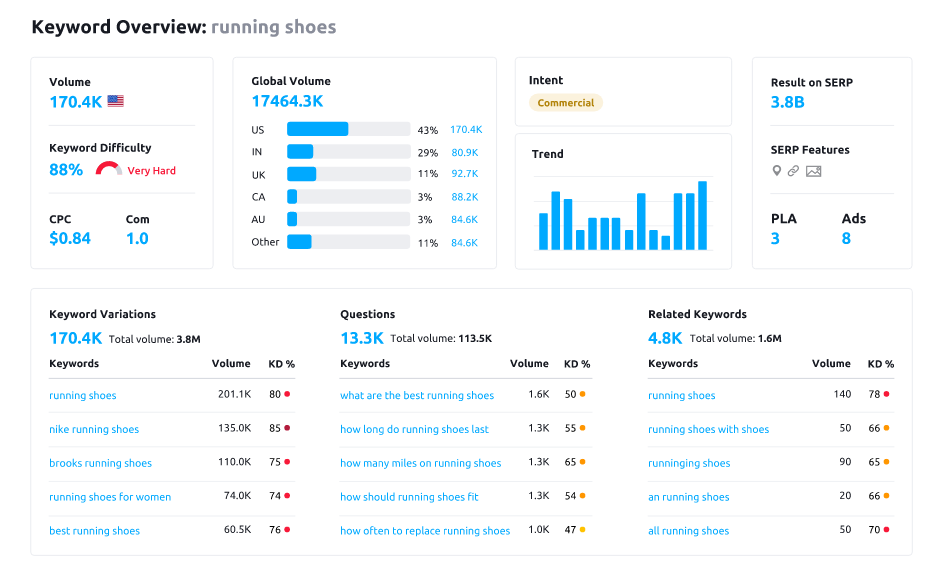
-Source: semrush
To find medium volume-low competition keywords in any niche, head over to SEMrush. Using the filter set the keyword search volume to a minimum of 1,000 and the keyword difficulty to a maximum of 20. Around 80% of your posts need to cover these keywords since they’ll generate the most revenue for your blog.
Pro Tip: When you find medium volume-low competition keywords go after them and publish content immediately. The metrics will change as more bloggers find these terms and target them over time.
When you’re analyzing how to choose a blog niche, you also need to think about finding very high volume-high competition keywords in your niche.
2. Very High Volume-High Competition Keywords
Very high volume-high competition is the second type of keywords that you need to target in your blog posts. These keywords will form the backbone of your blog. They are more difficult to monetize but can pull in a ton of traffic and help you increase the size of your email list.
Let’s consider the term How to Make Money Online.
- Keyword: How to make money online
- Search volume: 107,000
- Keyword difficulty: 63
- CPC: $1.97
On the surface, it is obvious that this keyword has a significantly higher search volume compared to best snowboard brands. As a result, landing an article in the top 10 positions on Google can generate 15,000-25,000 monthly visits to your blog. And with the variation of the keyword that you’ll also rank for, you can easily double this amount of traffic.
If we dig deep, we can see that the keyword contains “how-to” suggesting the post is informational rather than transactional. It also has lower search intent. With best snowboard brands, we can determine exactly what the user is looking for, whereas how to make money online is unclear. We’re not sure what exactly the user is searching for, as you can make money online in 100s of ways, including starting a blog, dropshipping, podcasting, freelancing, etc.
This is why the CPC – the commercial value of the keyword is only $1.97.
To find very high volume-high competition keywords, go to SEMrush. Using the filter options set the keyword search volume to a minimum of 20,000 and the keyword difficulty to a maximum of 75.
The keywords should appear in long-form, high-quality, detailed, informational blog posts, forming up to 20% of your overall content.
In summary, your goal when searching for keywords to target is to find very high volume-high competition terms to use in “how-to”, informational posts that solve a pain point for your audience. You also want to find medium volume-low competition keywords that can be paired with the word “best” and include them in a listicle, transactional posts to generate revenue.
This is how to choose a blog niche that you can tap into through keyword research that is both lucrative and generates a lot of organic traffic.
Some of the best keyword research tools that you can use include:
How to Choose a Blog Niche: Conclusion
In summary, choosing the right niche is an essential step in starting a successful blog. How to choose a blog niche that makes you money requires a strategic approach and prioritizes blogging and business indicators over personal passions. Focus on market research, earning potential, affiliate revenue, and keyword research, so you can make a data-driven decision about your niche and start a profitable blog that provides value to your audience.
How To Choose A Blog Niche: Related Articles
Here is some further reading on MonetizingOnline.com that you may find value in:
- How to Start a Blog in 2024: The Most Detailed Guide
- 51+ Best Web Hosting Services of 2024 (Revealed)
- How to Make Money Online in 2024 and Beyond (Realistic)
How To Choose A Blog Niche: FAQs
These are some of the most frequently asked questions on how to choose a blog niche.
What is the Best Niche to Start a Blog?
The best niche to start a blog depends on several factors, including audience size, growth potential, and monetization opportunities. Some popular niches that match these criteria are personal finance, health and wellness, technology, and lifestyle. Ultimately, the best niche to start a blog is one that aligns with your expertise or experience, so you can establish your authority and credibility with the space and has the potential for growth and profitability.
What Blog Niches are Most Profitable?
There are several profitable niches that you can consider as a blogger. Some of the most profitable niches are personal finance, health & wellness, technology, fashion, beauty, and lifestyle. These niches have large audiences, offering plenty of opportunities for partnerships, sponsorships, and advertising revenue. Additionally, niches such as pet care, DIY and home improvements, travel, food and cooking are also profitable due to their potential for affiliate revenue and sponsored content. Ultimately, the profitability of a niche depends on your ability to create high-quality content, build an audience, and leverage monetization strategies effectively.
What Niche is in-Demand?
Currently, personal finance, health and wellness including fitness and nutrition, entrepreneurship, and technology are in high demand. These niches have a large and engaged audience, as well as a variety of subtopics that can be explored in depth.
However, keep in mind that niche popularity can change over time, so it’s important to stay up to date with current trends within your chosen niche and pivot if the landscape changes.
What is the Most Competitive Niche?
The make money online niche, which includes topics such as affiliate marketing and blogging itself, is considered to be the most competitive; however it’s also one of the most lucrative. Other highly competitive niches include fashion, beauty, and lifestyle. These niches have a large number of bloggers and influencers vying for attention and traffic.
What is the Most Sold Niche?
The most sold niche can vary based on trends and market demand. However, niches related to e-commerce, digital products, and online courses are generally high-performing. These niches offer opportunities for creating and selling digital products or services, as well as partnering with brands and advertisers.
What is a Unique Niche?
A unique niche is a topic that hasn’t been heavily covered by other bloggers or businesses. It can be a narrow sub-niche of a larger topic or an emerging industry that is not yet mainstream. A unique niche can offer the opportunity to establish yourself as an expert in the field and attract a highly engaged audience.
Which Niche has the Highest Traffic?
Niches related to health and wellness, personal finance, and technology generally have the highest levels of traffic. These niches have a large number of people searching for information and advice, as well as a high level of competition for traffic and engagement.
What are Micro Niches?
Micro niches are highly specific sub-niches within a larger topic. They have a smaller audience but can be easier to dominate and attract highly engaged followers. Examples include vegan keto diets, minimalist home decor, indoor gardening, and gluten-free baking. Micro niches allow for a more focused and specialized approach to blogging, which can help to attract a more dedicated audience.



